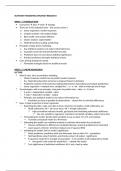Summary
Summary Marketing Strategy Research | MSc Marketing Management | RSM - Erasmus University
- Course
- Institution
Complete summary of all the lectures, tutorials and cases of the course Marketing Strategy Research given by Xi Chen in the master program Marketing Management. Good luck with studying!
[Show more]



